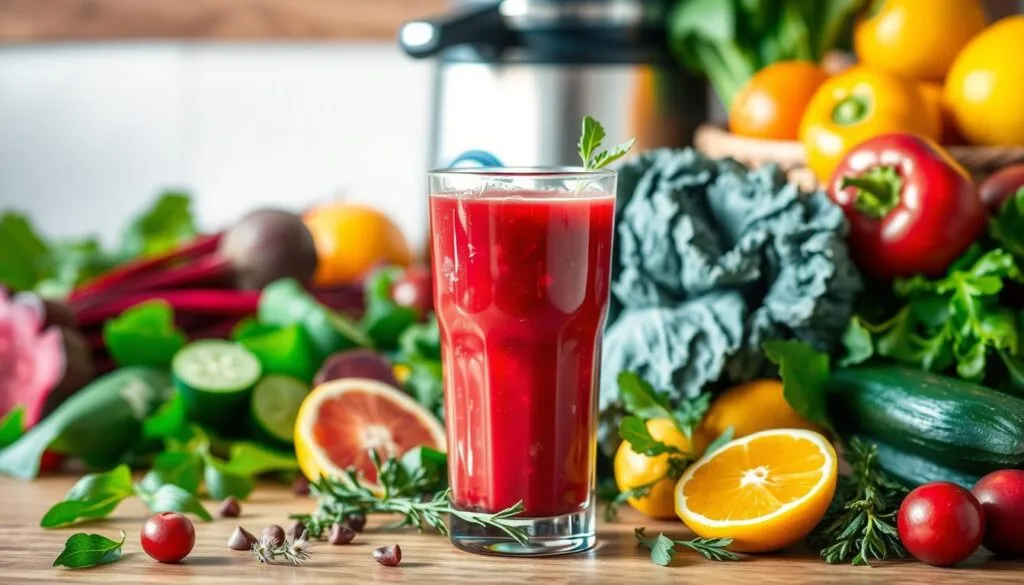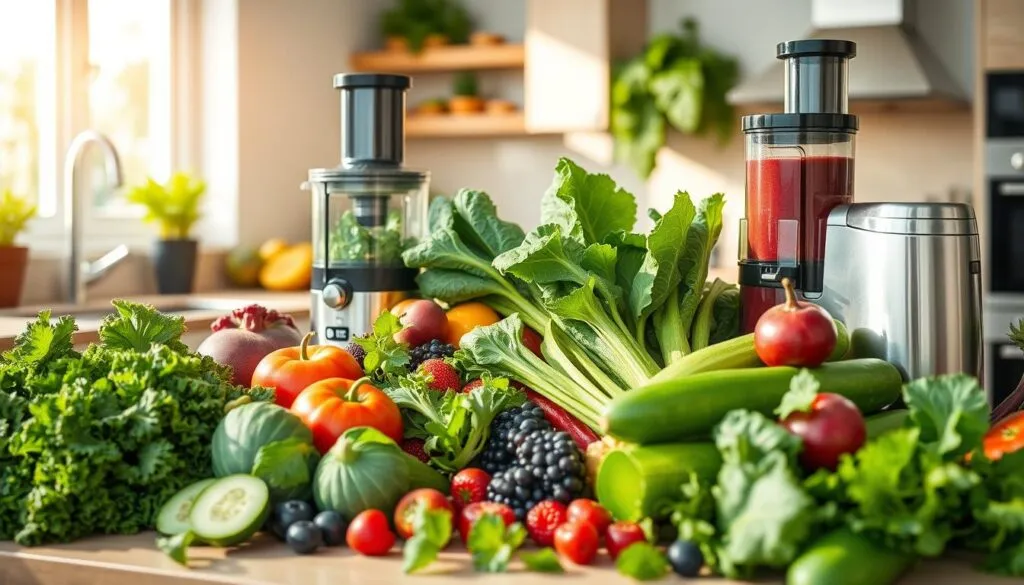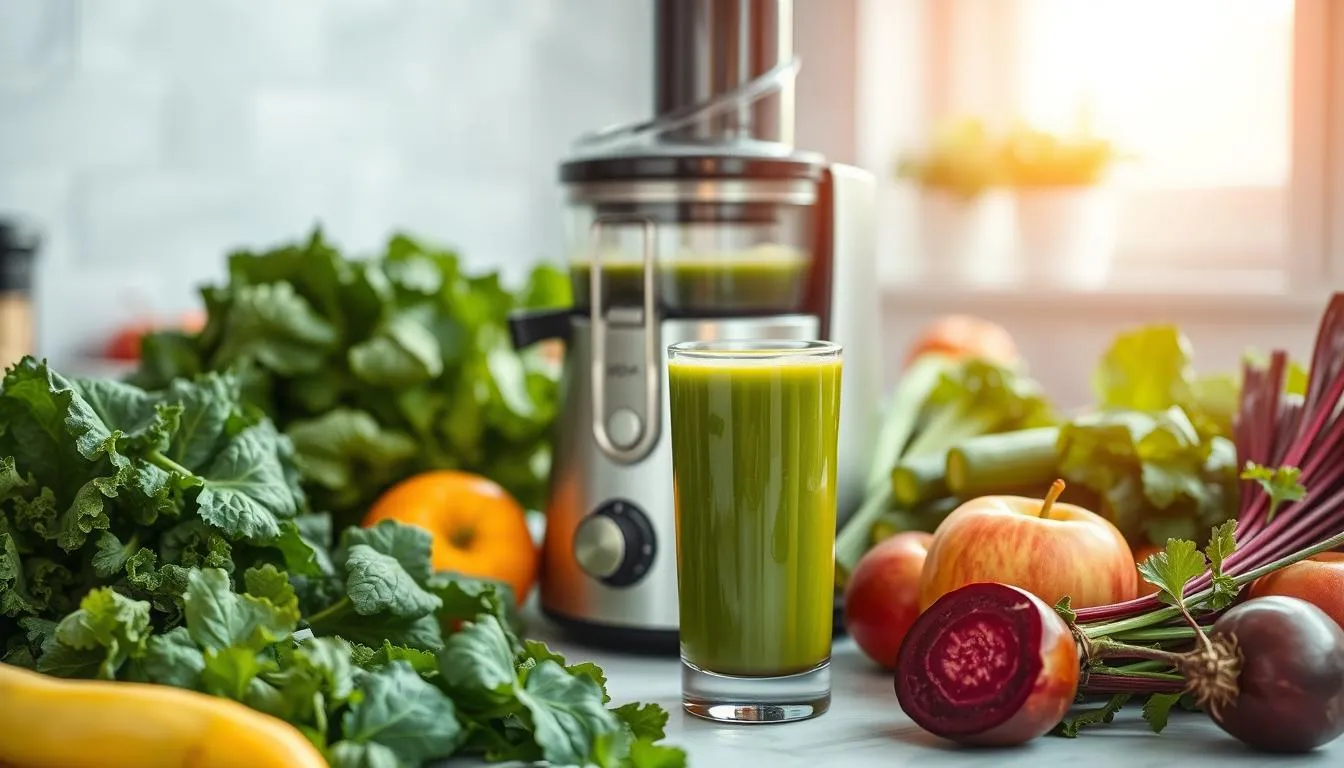Diabetes and juicing recipes Living with diabetes for years has taught me a lot about managing blood sugar. It’s hard to watch your sugar intake all the time. But, juicing can help you satisfy sweet cravings while keeping your health in check.
Let’s dive into the world of diabetes-friendly juicing recipes. Here, you can enjoy tasty, healthy drinks without worrying about your blood sugar.
In this guide, we’ll look at how juicing helps with diabetes. We’ll cover the best practices, key ingredients, and yummy recipes. This journey will nourish your body and delight your taste buds.
Table of Contents
Understanding Diabetes and Its Impact on Nutrition
Diabetes is a long-term condition that makes it hard for the body to control blood sugar. Eating right is key to managing it, as stable blood sugar is vital for health. Juicing can help, offering concentrated nutrients and fiber to control blood sugar.
What is Diabetes?
High blood sugar is a symptom of diabetes, a metabolic disease. It happens when the body doesn’t make enough insulin or can’t use it well. Heart issues, kidney disorders, and nerve damage may result from this.
The Importance of Blood Sugar Control
For diabetics, maintaining stable blood sugar levels is essential. High blood sugar can cause fatigue, thirst, and serious damage to organs. Eating right, exercising, and taking medication can help manage blood sugar.
How diabetes and juicing recipes Can Help
Juicing can help diabetics manage their condition. Cold-pressed juices keep more nutrients from fruits and veggies, like fiber, vitamins, and antioxidants. These juices can boost health and help with blood sugar control.
| Nutrient | Benefits for Diabetics |
|---|---|
| Fiber | Helps slow the absorption of carbohydrates, leading to more gradual increases in blood sugar levels. |
| Vitamins and Minerals | Provide essential nutrients for overall health and may improve insulin function. |
| Antioxidants | Help reduce inflammation and oxidative stress, which can be elevated in individuals with diabetes. |
Adding juicing to a diabetic’s diet can improve blood sugar management and overall health.
Benefits of Juicing for Diabetics
Juicing can change the game for people with diabetes. It uses fruits and veggies to boost antioxidants, fiber, and hydration. These are key for managing diabetes and staying healthy.
Nutrient Density and Digestibility
Juicing makes nutrients from fruits and veggies easier for your body to use. This means more vitamins, minerals, and antioxidants for your health. Research shows juiced produce can help control blood sugar and improve insulin use.
Natural Sweetness without Added Sugar
Juicing lets you enjoy sweet tastes without added sugars. Fruits add natural sweetness to juices. This satisfies cravings without raising blood sugar. Choose low-glycemic fruits and add veggies for a sweet treat that’s good for you.
Hydration and Overall Wellness
Staying hydrated is key for diabetics. It helps remove toxins, supports organs, and helps with weight. Juicing adds nutrients and increases your hydration intake. This can lead to better health and diabetes management.
Adding juicing to your life can be a big change. It helps control blood sugar, supports health, and offers a tasty, nutritious drink. It’s a fantastic method to achieve your health objectives.
Essential Ingredients for Juicing Recipes
Creating diabetes-friendly juicing recipes starts with the right ingredients. Choose nutrient-rich foods to make juices that keep blood sugar levels healthy. Let’s look at three key ingredient categories for your juicing routine.
Leafy Greens: Spinach and Kale
Vitamins, minerals, and fiber abound in leafy greens like kale and spinach. They’re great for managing blood sugar. Vitamins A, C, and K are abundant in spinach juice and are beneficial to your health.
Research shows that cold-pressed spinach juice can help control blood sugar. This is because it has a lot of magnesium, which is important for insulin.
Low-Glycemic Fruits: Berries and Apples
Low-glycemic fruits like berries and apples are perfect for juicing. Blueberries, for example, can improve how well your body uses insulin. This helps manage blood sugar.
Apples are also good because they’re high in fiber and have a low glycemic index. This means they won’t raise your blood sugar too much.
Healthy Fats: Avocado and Nuts
Healthy fats like avocado and nuts are important for your juices. They add nutrients and help you feel full. Avocado has monounsaturated fats that slow down carb absorption, helping with blood sugar.
Nuts like almonds and walnuts add healthy fats, protein, and fiber. They make your juices even more nutritious.
By picking the right diabetes-friendly ingredients and nutrient-rich foods, you can make tasty juices. These juices support your health and help manage blood sugar.
Juicing for Blood Sugar Control
Managing diabetes means balancing carbs with fiber-rich foods. A wonderful approach to do this is through juicing. It gives you a lot of nutrients without raising your blood sugar too much.
How to Balance Carbs with Fiber
Choose low-glycemic fruits and veggies for your juices. Leafy greens, berries, and citrus are good choices. They’re full of fiber and low in carbs, which helps keep your blood sugar stable.
Timing Your Juice Intake
When you drink your juice matters too. Have it 30 minutes before a meal. This helps prevent big blood sugar spikes. The fiber and nutrients in the juice slow down carb absorption, keeping your blood sugar balanced.
Pairing Juices with Healthy Meals
Pairing your juice with a protein or healthy fat meal boosts its benefits. This combo slows down sugar absorption, giving you steady energy. Try adding nuts, avocado, or a hard-boiled egg to your routine.
By using these tips, juicing can help manage your diabetes and improve your health. Always talk to your doctor before changing your diet or lifestyle.

Best Juicing Recipes for Diabetes
Adding diabetes-friendly juices to your day can be fun and healthy. These recipes taste great and help keep your blood sugar in check. They also boost your health with important nutrients.
Green Detox Juice
Begin your day with Green Detox Juice. It’s made with kale, cucumber, green apple, and lemon. This mix is full of antioxidants, fiber, and vitamins to help manage your blood sugar.
Berry Beet Smoothie
Try the Berry Beet Smoothie for a tasty energy boost. It has blueberries, beetroot, spinach, and a small apple. This smoothie is rich in antioxidants, fiber, and nutrients, perfect for a diabetic-friendly diet.
Cucumber Citrus Refresher
Stay cool with the Cucumber Citrus Refresher. It’s made with cucumber, grapefruit, and lemon. This drink is refreshing and keeps your blood sugar stable. A bit of stevia adds sweetness without raising blood sugar.
These juices are tasty and good for your health if you have diabetes. They offer a lot of nutrients, fiber, and low-sugar ingredients. Adding them to your daily routine can help keep your blood sugar stable and improve your health.
Tips for Making Juices Diabetes-Friendly
Juicing can be a great way to manage diabetes, but it needs to be done carefully. By following a few tips, you can make tasty, diabetes-friendly juices. These juices support balanced nutrition and keep blood sugar levels stable.
Portion Control and Serving Sizes
When juicing, it’s important to control portions. Aim for 4-6 ounces per drink. This helps manage the carbs from fruit and veggie sugars. Remember, one glass of juice can have a lot of carbs, so watch your carb intake all day.
Avoiding High-Glycemic Ingredients
Choose low-glycemic fruits and veggies for juicing. Avoid high-sugar fruits like tropical ones, which can raise blood sugar fast. Instead, use berries, apples, and citrus with greens like spinach and kale. This mix keeps blood sugar stable.
Incorporating Protein Sources
To make your juices more nutritious and filling, add protein. Use plant-based protein powders, Greek yogurt, or nut butters. This mix of carbs and protein slows down sugar absorption, making blood sugar changes more gradual.

Follow these tips to enjoy juicing while managing diabetes. Remember, being consistent and finding what works for you is key. Try different ingredients and see how your body reacts to find the best juicing routine.
Storing and Preparing Juices
Storing and preparing juices right is key to keeping their nutrients and ensuring safety. The right juicing techniques can boost the juice’s health benefits and keep it fresh longer.
Best Practices for Juicing
Invest in a top-notch cold-press juicer for the best juicing experience. These juicers work slowly, which helps keep nutrients in your juice. The Wipro Vesta FS201 Cold Press Slow Juicer, for example, runs at 55 RPM, ensuring your juice stays full of nutrients.
How to Store Fresh Juices
After juicing, store your juice right to keep it fresh and full of nutrients. Keep it in airtight containers in the fridge for up to 24 hours. This keeps the juice’s flavor and nutrients good while stopping bacteria.
Freezing Juices for Later Use
Freezing is a great way to store juices for longer. Fill small containers or ice cube trays with the juice, then freeze. This lets you enjoy your juices later without losing their nutrient content.
By following these tips, you can keep your homemade juices at their best. This ensures you get the most health benefits from your juices.
Combining Juicing with Other Healthy Practices
Managing diabetes requires a holistic approach. Juicing is a valuable tool, but it’s crucial to combine it with other healthy practices. This ensures the best results for your health.
The Role of Exercise
Regular exercise improves insulin sensitivity and blood sugar control. Activities like brisk walking, cycling, or swimming help your body use insulin better. Aim for 30 minutes of moderate exercise daily for the best benefits.
Mindful Eating Habits
Mindful eating is key to managing diabetes. Pay attention to how your body reacts to different foods and juices. This helps you find the right ingredients and portion sizes for healthy blood sugar levels. Take your time, savor your food, and pay attention to your body’s cues.
Supporting Supplements
Some supplements can support diabetes management. Cinnamon and chromium picolinate may help regulate blood sugar. But, always talk to your healthcare provider before adding new supplements. They can interact with medications or have side effects.
By combining juicing with regular exercise, mindful eating, and supportive supplements, you can improve your holistic health and diabetes management. Remember, your health journey is ongoing. Be patient and consistent with these practices.
Common Myths About Juicing and Diabetes
Managing diabetes can be tricky, especially with myths about juicing. To make wise decisions for your health, you must be aware of the facts.
Debunking Sugar Myths
Many think all fruit juices are bad for diabetes. But, not all juices are the same. Look for juices with low sugar, like green juices or berry juices. They can assist in maintaining steady blood sugar levels.
Clarifying the Role of Nutrients
Some believe juices don’t have as many nutrients as whole foods. But, juices pack a lot of vitamins, minerals, and antioxidants. Just remember to eat plenty of fiber-rich foods too.
Juicing vs. Whole Fruits and Vegetables
Juicing does lose some fiber, but it’s not all bad. It’s a good way to get more nutrients, as long as you watch your portions. Always eat whole foods too.
Using juicing wisely is key for diabetes management. You can make healthier decisions if you are aware of the facts.
Tracking Blood Sugar Levels
It’s key to watch your blood sugar when you start juicing. Seeing how your body reacts to different juices can teach you a lot. This helps you understand how juicing affects your blood sugar.
How Juicing Affects Blood Sugar
Some fruits and veggies in juices, like berries and leafy greens, can keep blood sugar steady. But, fruits high in sugar, like apples and pineapples, can raise it. Always check your blood sugar before and after drinking juice to see how it affects you.
Keeping a Juicing Journal
- Write down what you put in your juice, how much, and when you drink it.
- Test your blood sugar before and after drinking juice.
- Track any changes in energy, mood, or other symptoms.
- Look for patterns to find the best juices for you.
Understanding Your Body’s Response
By watching your blood sugar and keeping a juicing journal, you’ll learn a lot. This way, you can make a glucose monitoring and personalized nutrition plan. It will help you stay healthy and manage your diabetes better.
| Juice Ingredient | Effect on Blood Sugar |
|---|---|
| Spinach | Minimal impact, high in fiber and nutrients |
| Blueberries | Slow, steady rise in blood sugar levels |
| Apple | Moderate increase in blood sugar levels |
| Carrot | Gradual rise in blood sugar levels |
| Ginger | May help stabilize blood sugar levels |
“Juicing can be a powerful tool for diabetes management, but it’s essential to monitor your body’s unique response to ensure your blood sugar levels remain stable.”
Consulting with Healthcare Professionals
Managing your diabetes care is a team effort. Working with healthcare pros is key. Nutritionists and diabetic educators can help you make a juicing plan that fits your diabetes management strategy.
The Importance of Nutritionists
Registered nutritionists help people with diabetes eat healthy. They make meal plans just for you. They guide you on adding juicing to your diet, making sure it meets your blood sugar needs.
Working with Diabetic Educators
Diabetic educators focus on diabetes management. They teach you how juicing affects your blood sugar. They help you add juicing to your diabetes care plan.
Regular Health Check-ups
Seeing your doctor regularly is important with juicing and diabetes management. Your doctor checks how juicing affects your health. They look at your blood sugar, weight, and more. This professional guidance ensures your juicing supports your diabetes care.
“Consulting with healthcare professionals is essential for managing diabetes through juicing. They can provide personalized guidance and monitor the impact on your overall health and blood sugar control.”
Resources for Further Learning
Starting your juicing journey for better blood sugar control? There are many resources to help you learn more and connect with others. You can find books, online forums, and more to help manage your diabetes with juicing.
Recommended Books on Juicing
Check out “The Juicing Bible” by Pat Crocker for a deep dive into juicing. It has lots of recipes, techniques, and health benefits. “The Complete Book of Juicing” by Michael T. Murray is also great. It focuses on juicing for health issues like diabetes, backed by science.
Online Communities and Support
Join online communities to connect with others who manage diabetes with juicing. The American Diabetes Association forums are a great place to share recipes and tips. Reddit’s r/diabetes and Facebook groups for juicing and diabetes offer lots of support and advice.
Reliable Websites for Diabetes Information
For the latest on diabetes management, nutrition, and juicing, check out the National Institute of Diabetes and Digestive and Kidney Diseases (NIDDK) and the American Diabetes Association. These sites have guides, research, and advice to help you with your diabetes care and juicing.

